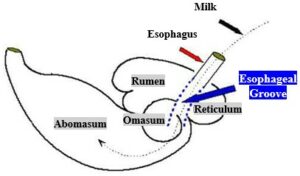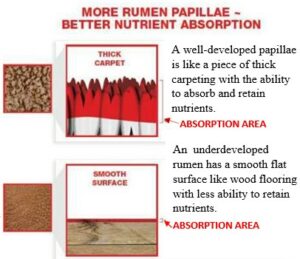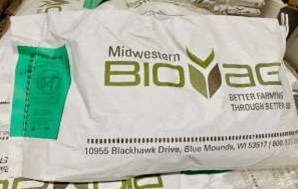When calves are born, they start out as simple stomached animals. The change from one digestive method to another is a process that is called rumen development. The first two compartments make up one large fermentation vat, the third is an unusual-looking organ that absorbs water and minerals from digesta leaving the rumen, and the fourth is the true stomach that functions like the stomach of monogastric (people and pigs). All four of these stomachs are present at birth; however, only the abomasum is fully developed and functional. The reticulum and rumen are sterile at birth, and it’s often several weeks before a constant bacterial population of an adult ruminant.
Calves need to start out on milk and milk replacer. However, milk and milk replacer does not allow for much growth or any maturation of the reticulum and rumen as they are being bypassed. Feed, most notably dry feed, has to remain in the rumen in order to begin the rumen development process. Dry feed, such as calf starter (grain mixtures) or forage, will not pass through the esophageal groove, and thus flows from the esophagus into the reticulum and rumen where digestion begins. Within two or three days of age, start to introduce a dry feed, such as calf starter. Grain is the key element of calf rumen development because of its involvement in volatile fatty acid (VFA) production to support papillae growth. Papillae are the finger-like projections that line the inside of the rumen. Papillae are essential for rumen function, as they increase the surface area for greater potential to absorb nutrients like a champ.
When dry feed enters the rumen, it absorbs water that the calf has consumed. That, along with the anaerobic (absence of oxygen) environment of the rumen, provides a perfect place for bacteria to grow. Calves need to start out on milk and milk replacer. However, milk and milk replacer does not allow for much growth or any maturation of the reticulum and rumen as they are being bypassed. Feed, most notably dry feed, has to remain in the rumen in order to begin the rumen development process. Dry feed, such as calf starter (grain mixtures) or forage, will not pass through the esophageal groove, and thus flows from the esophagus into the reticulum and rumen where digestion begins. Within two or three days of age, start to introduce a dry feed, such as calf starter.
Grain is the key element of calf rumen. As these bacteria grow and metabolize nutrients, they produce volatile fatty acids. The primary volatile fatty acids produced in the rumen are acetic, propionic, and butyric acids. This acid production lowers the pH of the rumen and establishes an even better environment for bacteria to continue their growth, especially for bacteria that digest starch and produce propionic and butyric acids.
Calf starter feeds contain carbohydrates in the form of starch which is fermented by bacteria that produce propionic and butyric acids. When forages are digested, due to the different species of bacteria that digest fiber, the primary end product is acetic acid. Acetic and propionic acids are absorbed through the rumen wall and are taken up by the blood and pass through the liver to be made into metabolites that can be used for energy sources by the calf. However, butyric acid is not absorbed through the rumen wall, and the cells of the rumen wall have an alternative metabolic process that allows butyric acid to be converted into an energy source for use by the cells in the rumen wall. Thus, butyric acid produced in the rumen primarily provides energy for the growth of the rumen wall. Acetic and propionic acids provide energy for the entire calf, part of which is shared to the rumen wall, but overall compared to butyric acid, much less acetic and propionic acids are used to fuel rumen development.
Once a significant amount of starter or grain is consumed by the calf each day (approximately 0.25 to 0.4 lb per day), it takes about 3 weeks to then develop the rumen to the point that this digestive organ by itself has an established microbial population and enough absorption capacity to allow the calf to continue normal growth once milk or milk replacer is stopped (weaning). If liquid feeds are removed before rumen development has occurred, the calf will not grow and may even lose body weight for 1 to 3 weeks until the time that the rumen is developed. Early grain introduction allows their small, non-functioning rumen to grow into the healthy, functional site of nutrient breakdown and absorption as a productive cow.
Product of the Week: “O” BioBaby Mixer Pellet
“O” BioBaby Mixer Pellet is a high-quality protein supplement formulated to mix with corn and oats for a complete calf starter.
-
-
-
-
-
-
-
- Contains BioBaby Premix vitamins and minerals
- Provides top-quality plant protein sources
- Contains kelp as a source of over 60 trace minerals and vitamins.
- Helps promote reproductive health, immune system function, and hoof
- Contains yeast culture and live, beneficial bacteria
-
-
-
-
-
-




